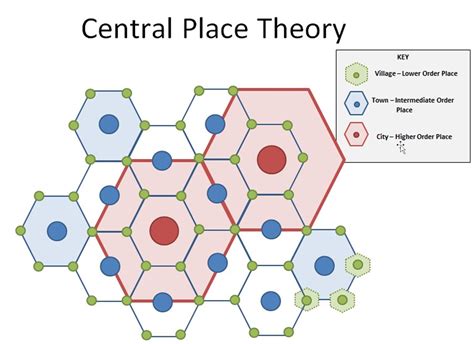Introduction
Walter Christaller’s Central Place Theory is a foundational concept in AP Human Geography, offering a framework for understanding the spatial distribution of settlements and economic activities. Developed in the 1930s, the theory postulates that certain services and goods are distributed and accessed by a hierarchical system of central places, ranging from small villages to major metropolitan centers.

Key Concepts
Central Place: A focal point of human activity that provides goods and services to a surrounding area.
Hinterland: The geographic area served by a central place.
Threshold Population: The minimum population required to support a specific good or service.
Range: The maximum distance people are willing to travel to access a good or service.
Hierarchical Structure
Christaller’s theory suggests that central places are organized in a hierarchical system, with lower-order centers serving only their immediate surroundings and higher-order centers offering a wider range of specialized services. This hierarchy reflects the varying threshold populations and ranges of different activities.
For example, a small village may only have a grocery store and a school (low-order centers), while a larger town might host a hospital and a university (high-order centers). Major cities, at the top of the hierarchy, provide the most specialized and comprehensive range of goods and services.
Spatial Implications
The central place theory has profound implications for the organization of human settlements and economic activity. By understanding the threshold populations and ranges of different goods and services, geographers can predict the distribution of retail, commercial, and industrial activities in a region.
This framework also helps explain the growth and decline of settlements. If a central place’s hinterland loses population or if the threshold population for certain services falls, the viability of that place may be diminished. Conversely, as population increases and economic activity expands, new central places may emerge or existing ones may grow in size and importance.
Applications
Urban Planning: The central place theory provides a blueprint for planning the distribution of services and amenities in urban areas. By considering the threshold populations and ranges of different activities, planners can create a hierarchical system that meets the diverse needs of a community.
Economic Development: The theory can also guide economic development strategies. By identifying areas with low levels of access to goods and services, policymakers can target investments to improve infrastructure and support the establishment of new central places.
Retail Marketing: Businesses can leverage the central place theory to determine the optimal location for their operations. By understanding the catchment area and potential market share of different central places, retailers can strategically position their stores to maximize customer reach.
Common Mistakes to Avoid
Oversimplification: The central place theory is a generalized model that may not accurately reflect the complexities of all real-world situations. Geographic factors, cultural preferences, and technological advancements can influence the distribution of goods and services.
Ignoring Competition: The theory assumes that central places are spatially isolated and do not compete with each other. However, in reality, businesses and services often compete for customers within a shared hinterland.
Static Analysis: The theory does not fully account for changes in threshold populations and ranges over time. As technology evolves and consumer preferences shift, the distribution of central places and economic activities may undergo dynamic adjustments.
Conclusion
Christaller’s Central Place Theory remains a vital tool for understanding the spatial organization of human settlements and economic activities. By providing a hierarchical framework for analyzing the distribution of goods and services, the theory enables geographers and policymakers to plan urban areas, support economic development, and make informed decisions about the location of businesses. While the theory has its limitations, it continues to offer valuable insights into the complex dynamics of human geography.
Additional Considerations
K-Values: Christaller’s theory proposes that the distance between central places is proportional to the square root of their populations. This relationship is expressed through “k-values,” which vary depending on the order of the central place and the type of good or service being offered.
Transportation Infrastructure: The development and accessibility of transportation infrastructure significantly impact the distribution of central places. Roads, railways, and waterways facilitate the movement of goods and people, expanding the hinterlands of central places and influencing their hierarchical relationships.
Technology and Globalization: Technological advancements, such as the internet and e-commerce, have challenged the traditional notion of central places. Online retailers can reach consumers over vast distances, disrupting the established hierarchy and creating new patterns of economic activity.
Social and Cultural Factors: Cultural preferences and social structures also play a role in shaping the distribution of central places. For example, communities with strong social ties may have more localized shopping and service patterns, while more individualistic societies may favor larger, regional central places.
Tables
Table 1: Central Place Hierarchy
| Order | Type | Example |
|---|---|---|
| 1 | Hamlet | Convenience store |
| 2 | Village | Elementary school |
| 3 | Town | Hospital |
| 4 | City | University |
| 5 | Metropolis | International airport |
Table 2: Threshold Populations and Ranges
| Good/Service | Threshold Population | Range (km) |
|---|---|---|
| Grocery store | 500 | 5 |
| High school | 5,000 | 15 |
| Hospital | 100,000 | 50 |
| University | 500,000 | 100 |
Table 3: K-Values for Different Order Central Places
| Order | K-Value |
|---|---|
| 3 | 3 |
| 4 | 4 |
| 5 | 7 |
| 6 | 9 |
Table 4: Applications of Central Place Theory
| Field | Application |
|---|---|
| Urban Planning | Design of retail and service clusters |
| Economic Development | Identification of underserved areas for investment |
| Retail Marketing | Optimal location of stores based on catchment areas |
| Geography | Understanding the distribution of human activities and settlements |
